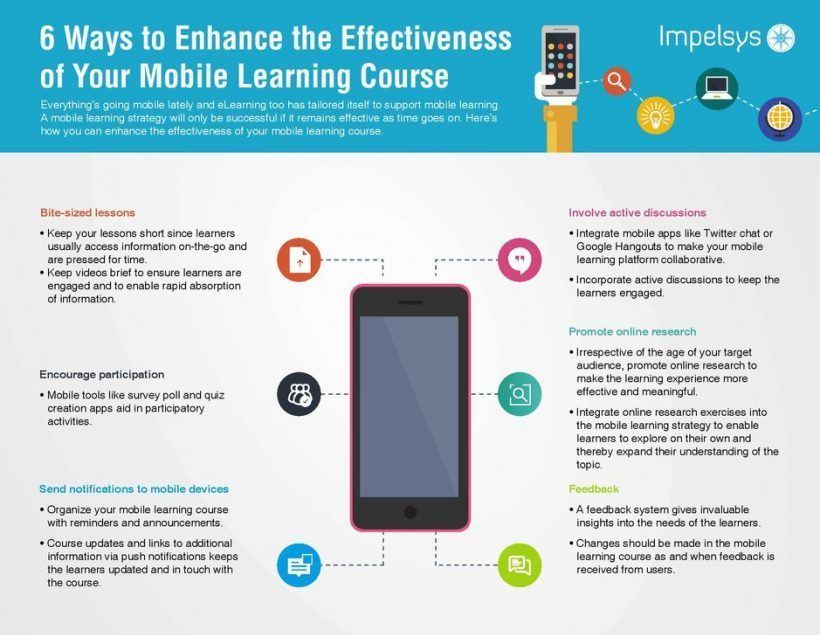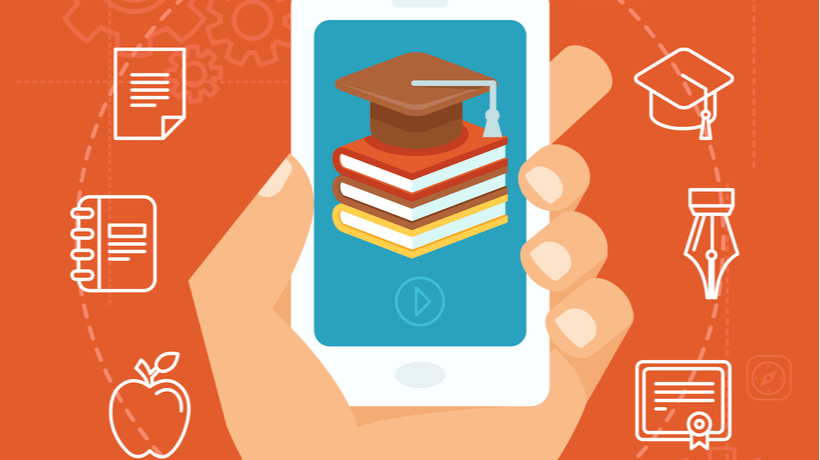How To Enhance The Effectiveness Of Your Mobile Learning Course
Everything’s going mobile lately and eLearning too has tailored itself to support mobile learning. However, creating a mobile learning strategy can be tricky for those who are unfamiliar with it. In this article, we will start with the basics before going into the details: First we will discuss about developing a mobile learning strategy, and then about how to enhance the effectiveness of your mobile learning course. Let us start with the steps involved in developing a mobile learning strategy.
5 Steps To Develop A Mobile Learning Strategy
Here is how to develop a mobile learning strategy:
1. Target Audience And Primary Objectives.
The first step is concerned with the identification of your target audience and determination of your primary objectives for the mobile learning course. "Target audience" is the people who will actually be accessing the information you provide. Remember that usually the target audience for a mobile learning course is people who are pressed for time. It is highly likely that a person chooses a mobile training course because they want to access the Learning Management System (LMS) from anywhere at any time. This would mean that the course content you design should only include information that is highly essential and can be comprehended in less time. Therefore, you will have to stick to relevant and concise course content (rather than comprehensive and long).
2. Course Distribution Choices.
The second step deals with determining how your mobile learning course is going to be distributed. You may be planning to make your content available for all mobile platforms, or could be either one or two popular ones, such as iOS and Android. In the ideal scenario, the mobile learning course will be distributed in all platforms and all devices. However, practically this can be very difficult; it would involve tailoring your content as well as its graphics to mobile devices with different screen sizes, resolutions, and other specifications. However, your course distribution choice should depend on factors like your target audience, subject matter, and the content itself.
3. Security.
Security is an important aspect of every mobile learning program. You have to make sure that your mobile learning platform has enough security measures, including encryption and password protection, to prevent unauthorized entries and allay other security related concerns. Keep in mind that smartphones are small computers which have the capacity to download information and perform unethical tasks involving retrieval of personal information. Therefore, keep all information encoded or carefully guarded.
4. Social Media.
Mobile learning is extremely personalized and asynchronous, as it involves each learner taking their time for learning and adopting a program or plan that suits them best. Mobile learning typically doesn’t involve any group activity or teamwork, and learning takes place at an individual level. However, it is highly beneficial to integrate social learning strategies into your mobile learning platform. This means that with the help of social media you will be able to transform your mobile learning experience into an interactive and engaging social learning experience. Social networks, collaborative learning tools, and group activities help bring social learning elements in your mobile learning program.
5. Testing.
Testing is the last step that precedes the official launch of your mobile learning course. Testing lets you identify technical errors or bugs and glitches that you have overlooked. Quality control is a term used to refer to the assessment or evaluation of performance of developed work or product. Quality control is done to ensure that your mobile learning course works well in all platforms and devices you intended for it to work on. Testing is usually followed by revision, where the errors that were identified are rectified.
The next step is launching, but it's not the end of a mobile learning strategy. An effective mobile learning strategy always involves continual assessment of the effectiveness of the course and the strategy itself. Therefore, a mobile learning strategy can be seen as a never ending strategy or a work always in progress. Once you launch the finished product in the market, you need to continuously assess the performance of your mobile learning platform, especially by getting feedback from the actual users through surveys and other methods. A mobile learning strategy will only be successful if it remains effective as time goes on. That is why it needs to be constantly evaluated and subsequently improved upon.
Furthermore, ensure that the assessment system of your mobile learning platform is useful. The goal of assessment is not to ascertain that the learners are getting good scores. A good assessment system will let you know whether the audience understands what is being taught to them. If the learners cannot grasp the concepts clearly, then the whole learning process is a waste of time. That is why the assessment system should measure how much the learners have understood. This involves asking interesting and thought provoking questions that engage the learners. Too much theory and long questions will only scare the learners away.
6 Guidelines On How To Enhance The Effectiveness Of Your Mobile Learning Course
Now it is time to look at the ways to enhance the effectiveness of your mobile learning course:
1. Bite-Sized Lessons.
Since the learners are using mobile devices and are also pressed for time, keep your lessons small. The learners usually access information on-the-go and prefer lessons that are brief and to the point. If you are thinking of creating videos, keep it brief (i.e. in the range of 2-4 minutes). Brief videos provide information in a convenient form which keeps learners engaged and also enables rapid absorption of information. Since your target audience will be accessing information from a variety of places, it is better to keep audio narration to a minimum.
2. Involve Active Discussions.
A mobile learning experience is complete only when there is an opportunity to effectively communicate and collaborate with peers. Also, learners should have the opportunity to interact with their instructors and receive support from their part. To make your mobile learning platform collaborative in nature, you can integrate mobile apps like Twitter chat or Google Hangouts: These will allow learners to interact with each other. Active discussions can keep the learners engaged in the learning process; they also provide enough motivation for them to continue whenever they find themselves in a tough situation. Discussions allow learners to share their experiences and explore ideas at length. This gives every member of your learning program an opportunity to voice their views and opinions to fellow-learners without any need of the physical classroom setting.
3. Encourage Participation.
Give the learners an opportunity to apply their learning. For example, let the learners become instructors once they gain enough information. This not only gives them a unique experience, but also helps in effective retention of information they already learnt. Give the learners an opportunity to explore the subject matter on their own and put the main ideas in their own words. Various mobile tools like survey poll and quiz creation apps aid in participatory activities.
4. Promote Online Research.
Irrespective of the age of your target audience, promoting online research will only make the learning experience more effective and meaningful. When you integrate online research exercises into your mobile learning strategy, the learners will get an opportunity to explore the topic on their own and thereby expand their understanding of the topic. This can be used to supplement the core learning program.
5. Send Notifications To Mobile Devices.
In order to keep your mobile learning course more organized, you can make use of reminders and announcements. These could include course updates and even links to additional information via push notifications on the mobile phones of the learners. This method helps keep the learners updated and in touch with the mobile learning course.
6. Feedback.
An important point to remember is that every mobile learning course should evolve along with the needs of the users and the technological advancements and trends in the world in order to be successful. A stagnant mobile learning course will never remain effective even if the best strategies were applied to develop it. Dynamism is an important element of every mobile learning course. That is why a feedback system is a must for a mobile learning course. Feedback gives invaluable insights not only into the needs of the learners, but also into what changes need to be made for the challenges faced by the learners to be overcome. This means that getting feedback is not sufficient: Changes should be made when feedback is received from users by consulting eLearning professionals. Only if the changes are made will the feedback be useful.
Now you have learnt how to develop a mobile learning strategy and also how to enhance the effectiveness of your mobile learning course. Applying these guidelines and methods to your mobile learning strategy will help make your mobile learning course a truly memorable experience for your target audience.









